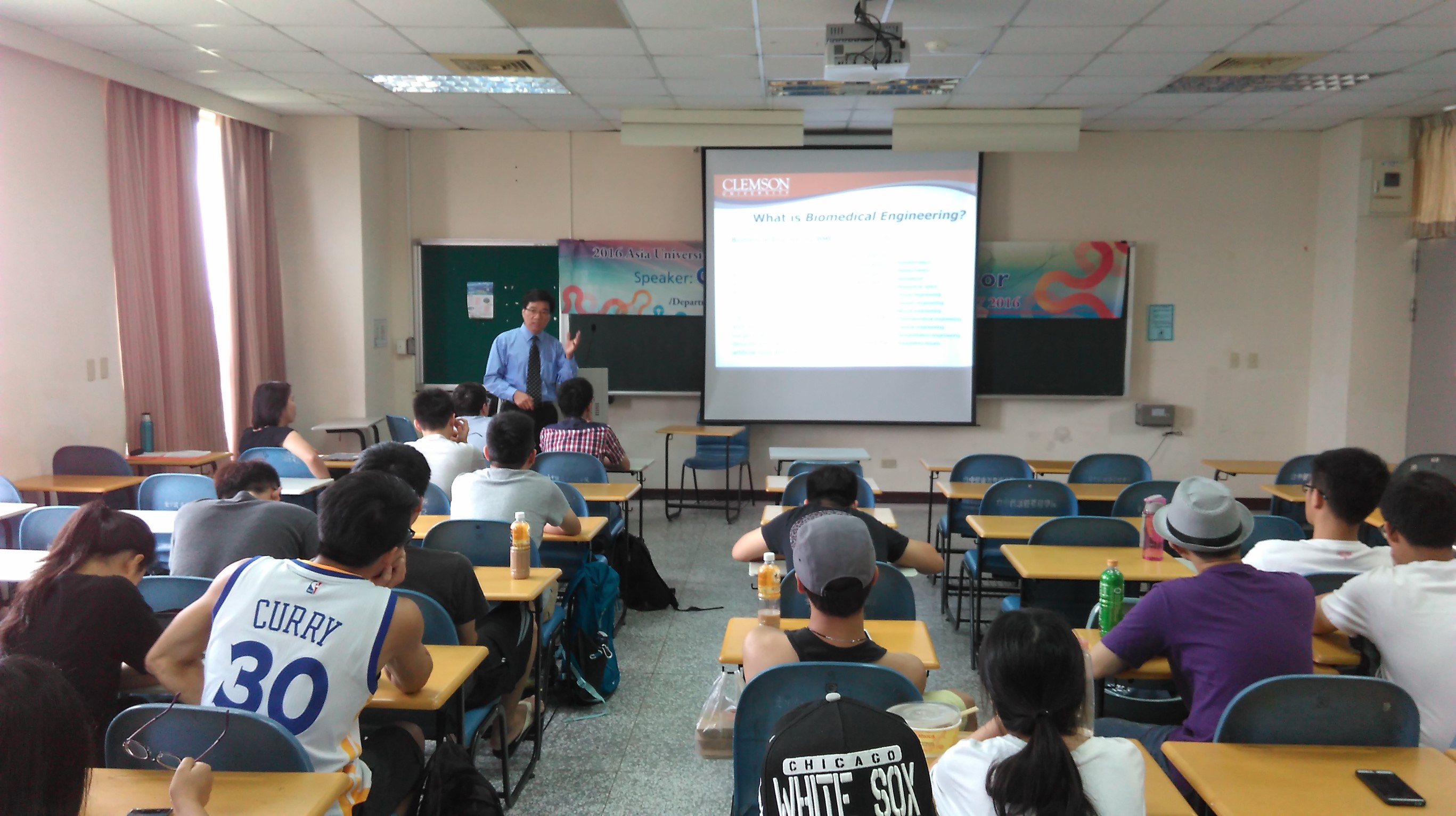全英學程

辦學理念
「國際一流綜合型大學」乃亞洲大學創設之願景,創立以來,本校便將國際化納入學校施政重要主軸。
學校深刻體認國際化乃高等教育之本質,更是大學競爭力之所在,尤其,現今社會在全球化的趨勢下,國際間之政治、文化、經濟面向皆已產生高度的互賴關係,而本校作為培育現代社會人才與傳播高等知識的場域,更必需因應全球化所產生的競爭與挑戰。
本校連續六年獲得教育部教學卓越計畫,國際化是教學卓越計畫的重點要項。
本校為了有效招收國際生,落實國際化校園理念,於99學年度於原有22個學系所,挑選具招生優勢以及全英語開課能力之13個學系所,包含生物資訊與醫學工程學系(前身為生物與醫學資訊學系),積極開設全英語授課學程,做為各學系的第二軌道學程,授課對象主要為國際生,本地生欲參加全英語授課學程,則必須通過多益550分、托福紙筆測驗457分、全民英檢中級或其他相等級之英檢。
教育目標
培養兼具工程技術,資料分析與生物醫學知識之專業人才,並增進領導管理及國際視野。

核心能力
具備數學、資訊、工程與生物醫學知識的能力。
策劃及執行專題研究的能力。
撰寫專業論文的能力。
創新思考及獨立解決問題的能力。
具備團隊協調合作之能力。
具國際觀及前瞻視野。
領導、管理及規劃的能力。
終身自我學習成長的能力。
畢業門檻
-
除「論文研討」,至少須修滿碩(博)士班開授課程24學分,以上學分不包括碩(博)士學位論文。
-
博士生須通過系所規定之資格考試及論文研究方向計畫書審查。
-
碩士生畢業者須發表一篇期刊論文或會議論文。除指導老師外,學生須為第一作者。博士生畢業者須發表一篇SCI級期刊論文及一篇EI級論文;除指導老師外,學生須為第一作者。
-
碩(博)士學位論文口試及格者。
課程內容
課程內容
|
Course Title |
Course description |
Credits |
|---|---|---|
|
This course is designed to give students a general understanding of the structural biology. Structural biology is a branch of molecular biology, biochemistry, and biophysics concerned with the molecular structure of biological macromolecules, specially proteins and nucleic acids, how they acquire the structures they have, and how alterations in their structures affect their function. This subject is of great interest to biologists because macromolecules carry out most of the functions of cells, and because it is only by coiling into specific three-dimensional shapes that they are able to perform these functions. This architecture, the "tertiary structure" of molecules, depends in a complicated way on the molecules' basic composition, or "primary structures." |
3 |
|
|
Data mining, or called knowledge discovery, is the processes of analyzing data from different perspectives, deriving useful information, and finally acquiring knowledge. The applications of data mining are now prevalent in varied domains, such as stock prediction, customer behavior analysis, and social network. In this course, we will learn what data mining can do and how to do it. Some important concepts and techniques, including association rules, clustering, classification, and artificial intelligence, will be discussed. |
3 |
|
|
This course is designed to give students an introduction to the methodologies, technologies, mathematics, and algorithms currently needed by people who do researches in learning with data. At the end of this course, students will possess the essential abilities to read academic papers and do their researches. Basic knowledge in calculus, linear algebra, statistics, and probability is helpful in this course. |
3 |
|
|
Digital image processing involves the acquisition, enhancement, display, and understanding of digital images. This course is designed to give students a general understanding of the fundamentals of digital image processing and to provide them with hands-on experience in designing and programming image processing algorithms. |
3 |
|
|
Pattern recognition aims to classify data (patterns) based either on a priori knowledge or on statistical information extracted from the patterns. This course is designed to teach students the basic techniques of pattern recognition and to show the students how to use such techniques for classifying real dataset, the assignment of a physical object or event to one of several prescribed categories. |
3 |
|
|
This course covers general knowledge representation techniques and problem solving strategies. Topics will include search, intelligent agents, game playing, rule-based systems, logic programming, semantic networks, planning, and uncertain reasoning. The aim of this course is to introduce the current range of AI-informed techniques for solving problems in computer science and biomedical research. |
3 |
|
|
The aim of this course is to provide students with a basic understanding of modern molecular biology. Topics in replication, dynamics of chromosome structure, regulation of gene expression will be discussed. Students will be able to use the knowledge they have acquired to develop projects in bioinformatics at the end of the course. |
3 |
|
|
This course covers the following topics: sequence alignment, dynamics programming, NCBI database, gene annotation, gene prediction, molecular phylogenetics, protein structure, and RNA structure. |
3 |
|
|
This course covers the following concepts: medical data acquisition, conversion, analysis and processing, elementary digital signal processing theory, and various applications in biomedical area. |
3 |
|
|
This course highlights how a biological problem can be transformed into a computational problem in a number of ways that feature different levels of accuracy and complexity. Highly accurate models often result in intractable computational problems while less accurate models may produce meaningless results. The main goal is to maintain an acceptable level of accuracy keeping the computational problem effectively solvable. |
3 |
|
|
The course offers an in-depth understanding of microarray technology, perform statistical analysis (t-test, chi-square test, F-test, test of hypothesis) of data, helping students get familiar with the internet resources. |
3 |
|
|
This course studies the genomes of organisms. The field includes intensive efforts to determine the entire DNA sequence of organisms and fine-scale genetic mapping efforts. The field also includes studies of intragenomic phenomena such as heterosis, epistasis, pleiotropy and other interactions between loci and alleles within the genome. Research of single genes does not fall into the definition of genomics unless the aim of this genetic, pathway, and functional information analysis is to elucidate its effect on, place in, and response to the entire genome's networks. |
3 |
|
|
This course is designed to give students a general understanding of the proteomics. Proteomics is the large-scale study of proteins, particularly their structures and functions. Proteins are vital parts of living organisms, as they are the main components of the physiological metabolic pathways of cells. The proteome is the entire complement of proteins, including the modifications made to a particular set of proteins, produced by an organism or system. This will vary with time and distinct requirements, or stresses, that a cell or organism undergoes. |
3 |
|
|
This course will help graduate students to develop their independent research ability. Students will have to present their papers related to the major topics in either bioinformatics or biomedical research. |
3 |
|
|
This course is designed to give students a general understanding of the systems biology. Systems biology is a term used to describe a number of trends in bioscience research, and a movement which draws on those trends. Proponents describe systems biology as a biology-based inter-disciplinary study field that focuses on complex interactions in biological systems, claiming that it uses a new perspective (holism instead of reduction). Particularly from year 2000 onwards, the term is used widely in the biosciences, and in a variety of contexts. An often stated ambition of systems biology is the modeling and discovery of emergent properties, properties of a system whose theoretical description is only possible using techniques which fall under the remit of systems biology |
3 |
|
|
This course is designed to introduce a variety of statistical models for time series and cover the main methods for analysing these models. The following topics will be cover; probability models for time series, stationarity, moving average (MA), autoregressive (AR), and ARIMA models. |
3 |



